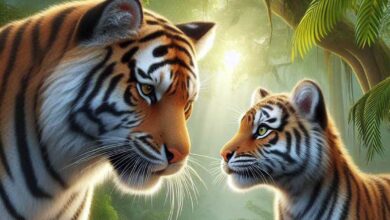Short-beaked echidna – spiny strongman
The short-beaked echidna (Tachyglossus aculeatus)
The echidna is similar to the hedgehog in its appearance and makes the impression of a rather strange, but rather harmless animal. In fact, it is extremely strong, and in captivity, it can demolish the cage. It is thought that one of bred species could carry the fridge around the room. It is said that one of the animals bred was able to move even… a fridge around the room.
Classification
- Kingdom: Animalia
- Phylum: Chordata
- Class: Mammalia
- Order: Monotremata
- Family: Tachyglossidae
- Genus: Tachyglossus
- Species: Tachyglossus aculeatus
- Name: short-beaked echidna
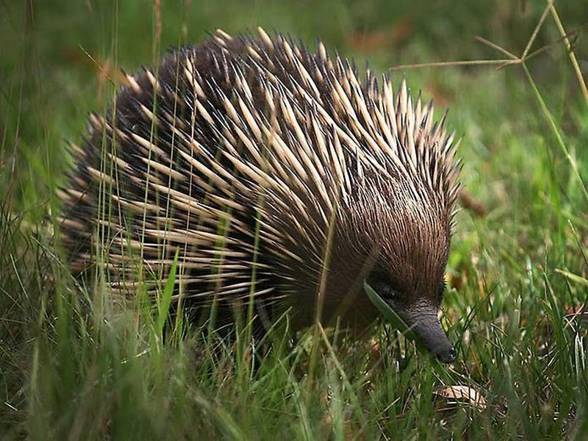
Evolution
The oldest fossils of the echidna come from the Pleistocene era, 15 million years back. They were found is the caves of southern Australia. Prehistoric echidnas are considered by researchers to be identical to their modern counterparts. The only difference between them is the size – current animals are about 10% bigger nowadays.

Subspecies and places of distribution
The short-beaked echidna lives solely on the area of Australia, Tasmania and New Guinea. There are five subspecies of the short-beaked echidna that can be found on different territories. These are:
- Tachyglossus aculeatus acanthion – it lives in Northern Territory and Western Australia
- Tachyglossus aculeatus aculeatus – it lives in Queensland, New Southern Wales, South Australia and Victoria.
- Tachyglossus aculeatus lawesii – it can be seen at the seaside and in the mountains of New Guinea as well as in rainforests of Northeast Queensland.
- Tachyglossus aculeatus multiaculeatus – it lives on the Kangaroo Island
- Tachyglossus aculeatus setosus – it lives in Tasmania and some islands of the Bass Strait
The natural habitat
The natural habitat of the echidna is woodlands and open but also mountainous areas, up to 2500 m (8200 ft) above sea level.

Characteristic
The short-beaked echidna resembles the hedgehog as far as the appearance is concerned. Its characteristic feature, however, is the long narrow and toothless snout. The mouth cannot open wider than 5 millimeters (2 in). Inside, there is 18 cm long (7 in) tongue, used to acquire food.
Because the echidna’s neck is completely invisible, the animal resembles a ball – its body and head seem to be joined together.
Strong thick and short legs are adapted for quick digging. Thanks to them, the animal can pull even the paving stone.
The echidna – apart from its face, legs and underside of the body – is covered with spines which are mainly made of the keratin. They are usually of the cream color but its taint depends on the geographical localization (the same case is with its fur). The hair has got different colors from honey to dark, reddish-brown.
Just as the duck-billed platypus, the echidna has a low body temperature – from 30 to 32 degrees Celsius (86 – 89.6 ℉).
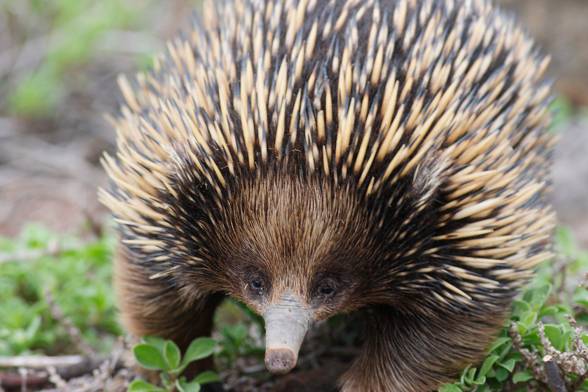
Senses
The eye structure of the echidna is a combination of reptiles’ and mammals’ features, but the ability to see is not very good in case of the echidna. The most important sense is the hearing making it possible to register low sounds, that is, those given out by ants and termites – echidnas’ food.
Unnecessary hibernation?
For scientists, it is unclear why echidnas fall in hibernation, although this is not necessary. This process starts when it is warm outside and animals have the access to a large amount of food.
Most likely, this is related to caution, the desire to save energy and maximize feeding efficiency.
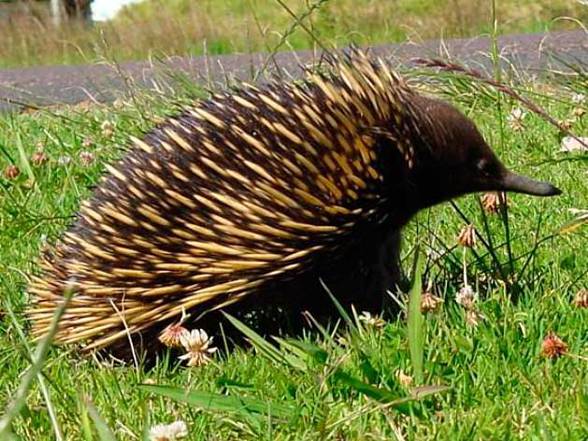
Diet
The echidna eats mainly insects and their larvae. Most of the time, its victims are ants and termites (similar to an anteater). It obtains food thanks to its long and sticky tongue, which can be easily put into the anthills and termite mounds as well as tree cracks. It also eats earthworms.
In desert areas, it can eat nothing for a few weeks, but when it finds for example a termite mound, it can eat 200 g (7.1 oz) of termites in 10 minutes.
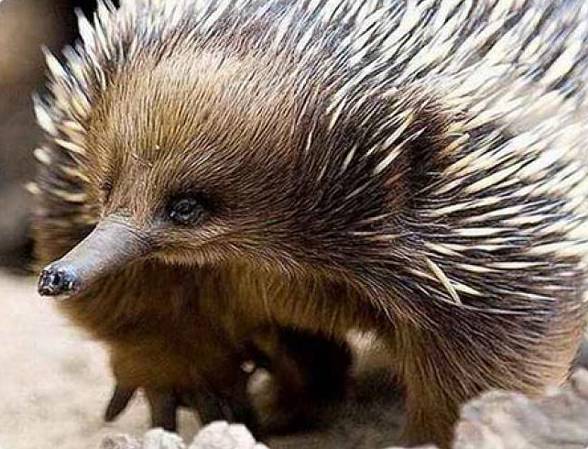
Lifestyle
The short-beaked echidnas are nocturnal and at daytime, they hide in burrows, dead trunks or rock crevices. When it feels safe in the area, it starts foraging in the afternoon.
In case of danger, the echidna can quickly burrow into the ground using all four limbs. On rocky areas, where it is not possible, it curls up in the shape of the sphere.
Echidnas are loners.

Reproduction and growth
The echidna, although it is a mammal, does not give birth to the young, but it lays eggs. Such behavior is a typical feature of the monotremes, and the spiny animal is one out of three living representatives.
The female lays one egg in a keratin sheath. Its diameter is 13-17 mm (0.5 and 0.7 in) and 1.5 – 2.0 g (0.053 – 0.071 oz) in weight. Pregnancy lasts from 21 to 28 days. During this time, the female builds burrows which act as kindergarten. Eggs are incubated for 10 days. Then, the young break through a soft, leather cover of the egg. It uses the horny appendage placed at the top of the snout.
Although the short-beaked echidna is a mammal – there are no nipples. Similarly to the platypus, the young are fed with milk flowing out of the specialized patches on the skin that secrete milk (monotremes lack nipples). There are about 100–150 pores. As a result of sucking, they are transformed into so-called pseudo-nipples.
The young is 1,5 cm (0.6 in) long and it weighs only 0,3 to 0,4 grams (0.011 and 0.014 oz). It stays in the female’s pouch till being 8 – 10 cm ( 3 – 4 in) long, that is around 7 weeks old. Then, spines start to be developed.
The young stay under mothers’ care for about a year.
In captivity, the short-beaked echidnas can live even up to 50 years old.

Detailed information / size
The short-beaked echidna (Tachyglossus aculeatus)
- Body length: from 30 to 45 cm (11.8 – 17.7 in)
- The length of the muzzle: up to 7,5 cm (2.9 in)
- Tail length: up to 10 cm (3.9 in)
- The length of spines: up to 5 cm (2 in)
- The length of the tongue: 18 cm (7 in)
- Weight: from 2 to 5 kg (4.4 – 11 lb)
The short-beaked echidna – curiosities
- The short-beaked echidna can be the carrier of the biggest fleas in the world reaching the length of 4 mm (0.016 in).
- Echidnas are extremely strong. Researchers observed an individual, which was carrying a 13 kg (29 lb) stone on its back.
- Echidnas roasted in the clay are Aborigines’ treat.
- The short-beaked echidnas are excellent swimmers.

Recommended
- Australia
- Goodfellow’s tree-kangaroo
- Tasmanian tiger
- Emu
- Cassowary
- Kangaroo
- Wombat
- Uluṟu-Kata Tjuṯa National Park
- Aboriginal Rainbow Serpent
- Diprotodon
- Marsupial lion
- Bunyip
- Yowie












